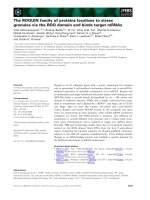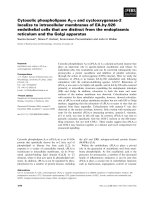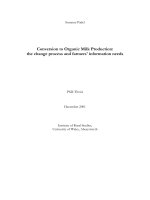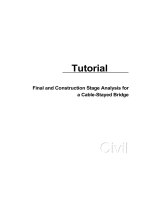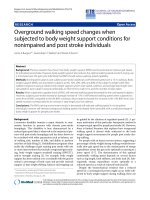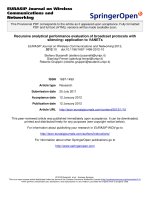RESEARCH OF CABLE STAYED BRIDGE VIBRATION SUBJECTED TO MOVING LOAD CONSIDERING THE VEHICLE VELOCITY AND BRAKING FORCE
Bạn đang xem bản rút gọn của tài liệu. Xem và tải ngay bản đầy đủ của tài liệu tại đây (1.07 MB, 27 trang )
MINISTRY OF EDUCATION AND TRAINNING
THE UNIVERSITY OF DANANG
TRAN VAN DUC
RESEARCH OF CABLE-STAYED BRIDGE VIBRATION
SUBJECTED TO MOVING LOAD CONSIDERING
THE VEHICLE VELOCITY AND BRAKING FORCE
SPECIALITY :
Engineering Mechanics
CODE
62.52.01.01
:
SUMMARY OF DOCTORAL DISSERTATION
DANANG - 2016
This Doctoral Dissertation was completed at
THE UNIVERSITY OF DANANG
Instructors:
1. Associated Prof. PhD. NGUYEN XUAN TOAN
2. Prof. PhD. NGUYEN TRAM
Reviewer 1: Prof. PhD. NGUYEN DONG ANH
Reviewer 2: Prof. PhD. NGUYEN VAN KHANG
Reviewer 3: PhD. VU DUY THANG
The Doctoral Dissertation defend at the University of Da
Nang on November, 04, 2016 at 14h30.
This Doctoral Dissertation can be found at:
Center for Information and Instructional Materials,
University of Da Nang.
1
INTRODUCTION
1. Reason for selection topics
Bridge construction technology has developed rapidly during the
recent two decades, particularly the technology built cable-stayed
bridge (CSB) span is increasingly more complete. CSB Structure has
been widely applied across the world, including Vietnam. The length
of large span CSB usually have to use all types of materials with high
strength, so the structure becomes more slender bridge and the
weight significantly reduces itself. CSB structure has a long span and
light self-weight will be very sensitive to the live load, as the load of
the traffic on the bridge, the wind, rain, earthquakes, etc. So far, there
were many studies of CSB oscillating under effect of the vehicle
loading. Most of the findings focus on the interaction model vehicle CSB ignored of the speed of change and braking force. In this thesis,
the author continues the study of oscillations CSB under effect of
vehicle loading into consideration the 3-axis variable speed and
braking force, one of the research problem necessary, scientific
significance and true reality.
2. Research objectives
Research objectives are vibration analysis and determination of
dynamics of CSB under effect of vehicle loading considering the
three-axle variable speed and braking force.
3. Subjects and scope of the study
Subjects research is vibration span of 02-span, 03-span CSB
under effect of vehicle loading considering the three-axle variable
speed and braking force.
2
Scope of the study is vibration in the vertical plane of the twospan and three-span CSB structure under effect of vehicle loading
considering the three-axle variable speed and braking force.
4. Research Methods
Research methodology is a combination of theoretical study
with experimental measurements. Research topic applied finite
element method (FEM) for structural modeling and loading through
using interaction model vehicle-CSB, application of the FEM and
the numerical methods to solve the problem of interaction and
analysis of CSB vibration under effect of vehicle loading considering
the braking force. Analytical results theoretically be verified by the
results of experimental measurements. Using the simulation program
to analyze the vibration of CSB and predicted the risk areas for the
bridge when subjected to vehicle loading considering effect of
braking force.
5. The significance scientific and practical applications
CSB very high-slender structure and light self-weight so
sensitive to dynamic loads, which vehicles loads of traffic on the
bridge had a significant impact on the longevity of CSB. Until now
there have been many studies of CSB vibration under effect of
vehicle loading. Most of the work was done on the interaction model
vehicle - CSB not considering the change of speed and braking force.
The study of vibration CSB under effect of vehicle loading
considering the change of speed and braking force is necessary. The
topic: “Research of Cable-Stayed bridge vibration subjected to
moving load considering the vehicle velocity and braking force”
3
that is significance science and high practicality. This study used the
simulation program to analyze the vibration of CSB and predict the
unsafe risk areas for construction under effect of vehicle loading
considering the braking force. Initial research results of the thesis
significance scientific and practicality high.
6. Thesis structure
In addition to the introduction, table of contents, list of
scientific works published by the author, reference list, the contents
of the thesis consists of 04 chapters, the conclusion and appendices as
follows:
- Chapter 1. Overview of bridges and CSB vibration under
effect vehicle loading
- Chapter 2. Theoretical basis of analyze dynamic interaction
between CSB and vehicle loading considering brake force.
- Chapter 3. Research theory and experiment of CSB vibration
under the vehicle loading considering braking force.
- Chapter 4. Analytical applications of CSB vibration under the
vehicle loading considering braking force.
- Conclusions and recommendations for follow-up studies.
- The appendix.
4
CHAPTER 1. OVERVIEW OF BRIDGES AND CSB
VIBRATION UNDER EFFECT VEHICLE LOADING
After the railway bridge collapse incident in the state Cheshire
Chester - England (05/1847), that has attracted the interest of many
scientists around the world involved in research in the field of bridge
vibrations under the influence vehicle loading. The authors studied
the vibration of the bridge due to load of vehicles, often considered
effects of factors such as vehicle speed, road surface condition,
loading models, bridge modelling, the interaction of the bridge
foundation and a few studies consider effect of vehicle braking force.
In general, the study of interactions between bridge and CSB under
effect of the vehicle loading
tend to focus more on theory or
experimentally, others tend to study combining both theoretical and
experimentally.
1.1. Researching of bridge vibration under effect of vehicle
loading more oriented to theory
The typical studies on construction vibration under effect of
moving load include: R. Willis (1849), E. & O. Morh Winkler
(1868), G. Stokes (1896), SAIliaxevic, AN Krulov (1905).
Subsequently, S.P.Timoshenko (1922) studied the problem extended
to the beam subject to vibration loading. Meizel (1930) solve the
problem with the load model does not damping, no inciting force.
Wen (1960) solved the problem for load moving on the uniform
beam. Sundara & Jagadish (1970) have solved the problem with the
model truck on the system of springs. In addition there are the relate
studies as Barchenkov (1976), Tran Quang Vinh (1978), Green &
Cebon (1995), Dongzhou, Wang Ton-Lo, Shahawy Mohsen (1995),
5
Fafard & Bennur (1997), Do Xuan Tho (1996), Yang YB & Yau JD
(1997), Wu YS & Yang YB & Yau JD (2001), Jalili & Esmailzadeh
(2002), Zeng & Bert (2003 ), Zhai WM, CB Cai, Wang KY (2004),
Ta Huu Vinh (2005), Lesław Kwasniewski (2006), Deng L. & Ca
C.S. (2009), Nan Zhang (2010), Wu & Law (2011), Neves, Azevedo
& Calcada (2012), Nan Zhang & He Xia (2013), Camara et al (2014),
Saeed A., Mijia Y. & Two Z. (2015).
The studies dynamic interaction between CSB and vehicle loading
may include various authors: Wilson & Barbas, Meurthe-et-Moselle
(1980), Rasoul (1981), Alessandri et al (1984), Brancaleoni,
Petrangeli & Villatico (1987), Khalifa (1991 ), Wang & Huang
(1992), Miyazaki et al (1993), Musharraf Z et al (1996), Yang F &
Fonder G (1998), Karoumi R (1998). In Vietnam, there are authors
Hoang Ha (1999), Nguyen Xuan Toan (2007), ... In addition, a few
studies on the dynamic interaction between bridges and vehicle
loading considering braking force such follows: Fry'ba (1974), Gupt
& Trail-Nash (1980), Mulcahy (1983), Krylov (1996), Toth & Ruge
(2001), Yang & Wu (2001), Law & Zhu (2005), Ju & Lin (2007),
Hossein & ... (2013 ).
1.2. Researching of bridge vibration under effect of vehicle
loading based on experimentally
The author Walther (1988), the authors Green M & Cebon D
(1994), the authors Nowak & Kim (1997), Chowdhury and Ray
(2003), Nguyen Xuan Toan (2007), Zhisong Z. & Nasim U. (2013).
The studies had based on the result of experiments to determine the
increasing in dynamics factor is usually denoted: dynamics impact
factor IM or (1+ IM)
6
1.3. Method of determining the dynamic impact factor of bridge
design code of some countries
According to the studies show that, the usual factor (1 + IM) in
bridge design codes can be defined in two ways: based on the length
determined or based on the frequency of span.
1.4. Conclusion of Chapter 1 and objective study of the doctoral
dissertation
- Research interactions between CSB and vehicle loading into
consideration the braking force by FEM with the four-mass model.
- Develop the KC05 program modules about CSB vibration analysis
under effect of three-axle vehicle loading considering braking force.
- Conducting experiments to measure vibrations of some bridges
aimed at adopting measures to verify the theoretical results.
- Compare the results of vibration analysis by theoretical and
experimental measurements. Through compare the results to assess
accuracy and reliability according to the theoretical calculation.
- Use Vibration Analysis Program (KC05) for assessment effect of
braking force to CSB vibration.
- Apply the confidence interval theories to determine the dynamic
impact factor of CSB considering braking force.
7
CHAPTER 2. THEORETICAL BASIS OF ANALYZE
DYNAMIC INTERACTION BETWEEN CSB AND VEHICLE
LOADING CONSIDERING BRAKING FORCE
2.1. General introduction
Chapter 02 will present the results using FEM methods for
analyzing vibration CSB problems under effect of vehicle loading
takes into account braking force.
2.2. Dynamic interaction model between three-axle vehicle and
beam elements
Dynamic interaction model between three-axle vehicle and beam
element take into account braking force is described as shown in Fig
2.2
Fig. 2.2. Interaction between three-axle vehicle and element beam
2.3. The calculation assumptions
- Mass of the entire vehicle and goods except the mass of vehicle
axles is transferred to the center of the system is equivalent to m and
rotational inertia J. The mass of the ith vehicle axles is mi considered
as a point with volume of concentrate of the ith corresponding vehicle
axles. The chassis is assumed stiff absolute and not deformed when
8
vehicle moving. Beam material working in the linear elastic stage.
Flat of bridge deck, the friction coefficient is uniformed over the
deck. The braking force of the vehicle axles is assumed that occurs
simultaneously.
2.4. Vibration differential equation considering braking force
2.4.1. The equations of three-axle vehicle loading balancing
n
Fsi m g 0
P mu
i 1
i mi g 0
Fsi Fti mi .u
n
n
T (m
mi ). s 0
ti
i 1
i 1
n
n
n
i 1
i 1
i 1
P m.u m.g .xo m.s.(h u) J . (mi .ui mi .g ).xi mi .s.(hi ui ) (Tti .wi Fti .xi ) 0
2.4.2. The equation for bending and longitudinal vibration of beam
element subject to vehicle loading
4w
5w
2w
w
EJ d . 4 . 4 Fd . 2 .
t
x
x
.
t
t
EFd .
n
p ( x, z , t )
i
i 1
n
2u x
2u
u
Fd . 2x . x q( x, z, t ) . pi ( x, z, t )
4
t
x
t
i 1
J .
n
d
si ( xi
xo ) 2 .
i 1
[
n
d
i 1
n
k
si ( xi
xo ) m.s].u
i 1
m.u
n
d
si ( xi
xo ).ui
i 1
n
[k
si ( xi
si ( xi
xo ).
i 1
n
d
i 1
si .u
xo ) mi .s].ui
si ( xi
xo ) 2 .
n
n
T .w (m.h m .h ).s 0
ti
i
i
i 1
n
d
n
k
i 1
i 1
n
d
xo ).u
si ( xi
si .ui
i 1
n
k
si ( xi
xo ).
i 1
i
i 1
n
k
si .u
i 1
n
k
si .ui
P m.g 0
i 1
mi .ui d si ( xi xo ). d si .u (d si d ti ).ui k si ( xi xo ). k si .u
(k si kti ).ui d ti .w i kti .wi mi .g 0
s g.
i d si ( xi xo ). d si .u d si .ui
pi ( x, z, t ) ( xi ).Fti . ( x xi ) ( xi ).[mi .u
ksi ( xi xo ). ksi .u ksi .ui mi .g ]. ( x xi )
with ( xi ) 1
0
khi 0 xi L
khi xi 0 & xi L
: the signal control function logic
( x xi ) is Delta-Dirac function; n=3; i= 1,2,3
9
2.4.3. Transformation the differential equations variation in matrix
form
Using the Galerkin method combined with Green theory, each
part integrating for each element and taken as matrix form:
Ce .q K e .q f e
M e .q
q, q, q, f e - acceleration vector, velocity vector, displacement vector,
the vector of the entire system, respectively.
Me, Ce, Ke – mass matrix, damping matrix, stiffness matrix of the
entire system, respectively.
M
M e ww
M zw
M wz
C
; C e ww
M zz
C zw
K ww K wz
C wz
; Ke
C zz
K zw K zz
M ww , Cww , K ww - mass matrix, damping matrix, stiffness matrix of the
beam elements, respectively.
2.4.4. The differential equations vibration of cable element:
Based on studies of Shimada (1994), Zui Hiroshi et al (1996),
N.X.Toan (2007), we get the differential equations of the cables
element vibration taking into account stiffness and weight of cable
components.
2.5. Application algorithms and establish analysis modules for
interactive dynamics of CSB and three-axle vehicle loading
considering brake force
2.5.1. General algorithm of CSB vibration analysis program under
effect of three-axle vehicle loading considering brake force
Analysis program is written in Delphi algorithm is described as a
flowchart as shown in Figure 2.5:
10
Begin
1
- Nodes, joints, beams element and
cables element data.
- Data from the three-axle vehicle
- Time at braking
- Revising coordinate of nodes.
-Determination Q and K
considering cable tension
1
- Điều chỉnh lại tọa độ nút.
Set
conditions
for
- Xácoriginal
định lại {q}
và K có xét
(hình
problem:
t 0,
Q 0,cáp
Q
0.
đến lực căng
trong
2.4)
i=1
- Establishment of Mww, Cww, Kww, fw
for the beam element ith
i=i+1
i=1
- Make the matrix transpose.
- Transpose, located and arrange into
the whole matrix: M, C, K, F
Ư
Make the matrix: Mwz, Mzw, Mzz,
Cwz, Czw, Czz, Kwz, Kzw, Kzz, fw, fz.
Cài đặt các điều
i = 1kiện ban đầu:
i ≥ SPTTD
_
i=i+1
+
i=1
- Establishment of Mww, Cww, Kww, fw
for the cable element ith
i=i+1
- Make the matrix transpose.
- Transpose, located and arrange into
the whole matrix: M, C, K, F.
_
i ≥ SPTC
+
Set boundary conditions for problem
Solving the equation:
K.Q = F
1
- Make the matrix transpose.
-Transpose, located and arrange
into
the{ whole
matrix: M,
C, K,
t=0,
}=0,{
}=0.
F.
i=i+1
_
i ≥ SPTL
+
- Make Kn with Q; Make K with Kn
- Determination: kl, k2, k3, k4, k5.
Ư
+ Q , Q
i≥with
- Calculating Q,
SPTL Runge – Kutta –
Merson.
t=t+h
+
t=t+h
_
t ≥ Th
+
coordinate system.
- Out put Q, Q , Q
- Calculate and output +the results of the
internal forces, stress,
for
t ≥ Tstrain
h
each element
+
End
End
Figure 2.5. The algorithm of CSB vibration analysis program
2.5.2. Build modular of static analysis and vibration of CSB under
effect of three-axle vehicle loading considering braking force
The main interface of the KC05 program developed when adding
modules as shown in Figure 2.6. On the main interface of the
software have items: Input the structure model, enter the technical
parameters of structures and vehicles, input the parameters related to
the analysis step, acceleration vehicle when braking, static analysis,
dynamic analysis, printing the analysis results.
11
Figure 2.6. The KC05 software interface after developed module
2.5.3. Assessment results of KC05 program for bridge and CSB
vibration analysis subject to vehicle loading considering braking
force
The author selected Hoa Xuan bridge, Da Nang (continuous girder
bridge) to verify theory results. The difference between experimental
measurements and theoretical results was 5.9%, quite reasonable.
2.6. Conclusions of Chapter 2
The author has established computational models of beam element
under the three-axle vehicle loading considering braking force. Build
of vibration equations and applications FEM analysis of CSB
vibration under vehicle loading considering the braking force. Base
on the program KC05, build additional modules of CSB vibration
analysis considering the braking force. Simultaneously, the author
has carried out experimental measurement for Hoa Xuan bridge to
verification of results theoretical analysis.
12
CHAPTER 3. RESEARCH THEORY AND EXPERIMENT OF
CSB VIBRATION UNDER VEHICLE LOADING
CONSIDERING BRAKING FORCE
3.1. General introduction
For a basis for evaluating the rationality of the results of FEM
analysis, the author has carried out experiment to measure reality
vibration of Pho Nam bridge in Da Nang.
3.2. Experimental measurement at Pho Nam bridge, Da Nang
3.2.1. Introduction of Pho Nam bridge
Pho Nam bridge is a cable-stayed bridge across the Cude river,
Hoa Bac commune, Hoa Vang district, Da Nang.
3.2.2. Technical parameters of Pho Nam bridge and vehicle testing
3.2.2.1. Technical parameters of Pho Nam bridge
Bridge span: 35,7m +80m+ 35,7m, with steel girder 2xI600, bridge
tower: I700&I500. Technical parameters of the beam: E=2,1x108T/m2;
Jd=0,001702m4; Fd=0,02568m2;qy=Fd= 2,035T/m; g=9,81m/s2;
3.2.2.2. Technical parameters of vehicle testing
Technical parameters of KAMAZ-5111: m=8,56T;m1=0,06T;
m2=0,11T;
m3=0,11T;P=0;b1=2,09m;b2=0,39m;b3=2,07m;h=0,95m;
h1=h2=h3=0,51m;k1s=120T/m;k1t=220T/m;k2s=k3s=160T/m;k2t=k3t=32
T/m; d1s=0,734Ts/m;d1t=0,367Ts/m;d2s=d3s=0,4Ts/m; d2t=d3t=0,8 Ts/m.
3.2.3. Order of experiments
Order of experiments: Collect data, determine the loading
parameters, installation location surveying of equipment, moving from
10 km/h ÷ 40 km/h.
13
3.2.4. Results of experimental measurement at the Pho Nam bridge
There are 02 transducers of the beam at position 1 and 2, while the
remaining 02 transducers will measuring displacement of the cable at
position 3 and 4, as shown in Figure 3.8.
21.68m
3 4
O
1 2
35.7m
80m
35.7m
Figure 3.8. Installation of the measuring equipment on the Pho Nam bridge
3.2.4.1. Results of measurement of the dynamic impact factor when
variety of vehicle speed and brake positions:
Figure 3.13. (1+IM) at the position 1, 2, 3, 4
3.2.4.2. Results of measurement of the dynamic impact factor depend
on braking position when constant velocity:
Figure 3.21. (1+IM) at the positions when the speed v=10÷40km/h
14
3.3. Comparison of the calculated results of dynamic impact
factor in theory and experimentally
3.3.2. Some experimental measurements at Pho Nam bridge
The vehicle speed of 20km/h and 25km/h, and braking at 1/4 and 1/2
of span is received from experiment equipment as shown Fig. 3:22.
Figure 3.22. Deflection at node 02 when braking at the 1/4 span (v=20km/h)
3.3.2. Modeling and application FEM methods for Pho Nam bridge
vibration analysis
Dyamic interaction model between CSB and vehicle loading
considering the braking force is described as shown Fig. 3.30:
tower
cable
vehicle
beam
pin support
Fig 3.30. Dyamic interaction model between CSB and vehicle
15
3.3.3. Comparing the results of theoretical analysis and
experimental measurement Pho Nam bridge, Da Nang
Table 3.3. The comparison of dynamic impact factor when analyzing in
theory and experiment
Def.
position
Node 2
Node 3
Node 2
Node 3
Node 2
Node 3
Node 2
Node 3
Braking
position
1/4 L
1/4 L
1/2 L
1/2 L
1/4 L
1/4 L
1/2 L
1/2 L
Speed
of
braking
(km/h)
20
20
20
20
25
25
25
25
Theory results
Experimental
results
qd
(mm)
4.918
5.293
4.711
6.048
5.292
5.831
5.092
5.780
qd
(mm)
4.424
4.529
4.048
5.393
4.770
5.395
4.508
5.279
1+IM
1.227
1.154
1.175
1.225
1.320
1.206
1.260
1.163
1+IM
1.164
1.105
1.079
1.135
1.255
1.148
1.156
1.111
Difference
between
theory and
experimentally
qd
IM
(%)
(%)
11.2
5.4
16.9
4.5
16.4
8.9
12.1
7.9
10.9
5.2
8.1
5.1
13.0
9.0
9.5
4.6
3.4. Conclusions of chapter 3
- The author has carried out experiments in the field to determine
reality dynamic impact factor of Pho Nam bridge, Da Nang. After
comparing reality measurements and theoretical analysis showed
dynamic impact factor according to theoretical analysis quite
matching the experiment. The greatest difference between these two
results for Pho Nam is 9.0%. Thus, the dynamic impact factor result
when analyzing in theory be trusted. Experimental results measuring
dynamic impact factor at Pho Nam bridge with vehicle speed from
10km/h to 40km/h with maximum value is 1,389.
- Based on the trend line on the chart experiment measurements
when moving at speeds between 10÷40km/h showed (1+IM) tends to
increase as the vehicle speed increase at braking when braking
position as far as bearing the (1+IM) tends to decrease.
16
CHAPTER 4. ANALYTICAL APPLICATIONS OF CSB
VIBRATION UNDER THE VEHICLE LOADING
CONSIDERING BRAKING FORCE
4.1. General introduction
In this chapter will present contents of using the program KC05
after the upgraded to analyze dynamic interaction between 02-span,
03-span CSB and three-axle vehicle considering braking force.
4.2. Vibration investigation of CSB subject to vehicle loading
with variety velocity considering braking force
4.2.1. Vibration investigation of Pho Nam bridge, in Da nang
Conducting a investigation of (1+IM) at nodes: 4, 7, 8, 9 24, 29,
39, 40 as shown in Fig. 4.1.
Figure 4.1. Pho Nam bridge, Da Nang
Vehicles derived from the left end of the bridge, running with the
speed of 5÷50 m/s and put the brakes at nodes:4, 5, 6, 7, 8 respectively.
Figure 4.2. Dynamic impact factors of axial displacement when braking at
position is 13m away from the left bearing
17
Figure 4.2. Dynamic impact factors of axial displacement when braking at
position is 20m away from the left bearing
Fig. 4.2 and Fig. 4.5 describe the variety of dynamic impact factors
when vehicle speed from 5 to 50m/s, maximum value is 2.089 and
2,137 with speed 45m/s and 35m/s, using the brake. Similar to other
results.
4.2.2. Vibration investigation of Nhat Le_02 bridge, Quang Binh
Conducting a investigation of (1+IM) at nodes: 2, 4, 6, 8, 10, 17,
19, 21 as shown in Fig. 4.26.
Figure 4.1. Nhat Le_02 bridge, Quang Binh
Vehicles derived from the left end of the bridge, running with the
speed of 5÷80 m/s and put the brakes at nodes: 2, 6, 10, 14, 18, 22.
18
Figure 4.27. Dynamic impact factors of axial displacement when braking at
position is 16,6m away from the left bearing
Figure 4.30. Dynamic impact factors of axial displacement when braking at
position is 54,2m away from the left bearing
Fig. 4.27 and Fig. 4.30 describe the variety of dynamic impact
factors when vehicle speed from 5 to 80m/s, maximum value is 3,589
and 3,471 with speed 70m/s, using the brake
4.3. Vibration investigation of CSB subject to vehicle loading
with variety velocity considering braking position
4.3.1. Vibration investigation of Pho Nam bridge, in Da Nang
Conducting a investigation of (1+IM) for Pho Nam bridge subject
to the KAMAZ-5111 dumper truck, using brake at positions is 13m
to 108,5m away from the left bearing.
19
Figure 4.45. Dynamic impact factors of axial displacement when v=5m/s
Fig. 4.45 describes the variety of dynamic impact factors when
vehicle speed of 5m/s and brake at nodes: 3, 4, 5, 6, 7, 8, 9, 10, 11, 12.
4.3.2. Vibration investigation of Nhat Le_02 bridge, Quang Binh
Conducting a investigation of (1+IM) for Nhat Le_02 bridge
subject to the ASIA dumper truck, using brake at positions are
16,6m, 54,2m, 91,8m, 189,4m, 227m, 264,6m away from the left
bearing..
Figure 4.75. Dynamic impact factors of axial displacement when v=5m/s
Fig. 4.75 describes the variety of dynamic impact factors when
vehicle speed of 5m/s and brake at nodes: 2, 4, 6, 8, 10, 17, 19, 21.
20
4.4. Analysis of dynamic impact factor results based on
confidence intervals
Author application probability theory to analyze statistical (1+IM)
data as calculated by the FEM based on confidence. In this case, the
sample is a random set of (1+IM) at each node when moving at
different speeds and braking at different positions on the bridge
4.4.1. Determining (1+IM) in the confidence interval theory
Results (1+IM) of the Pho Nam bridge according to the 90%,
95%, 99% and 99,99% confidence interval of the axial displacement,
vertical displacement and angular displacement at nodes 4, 7 , 8, 9,
24, 29, 39, 40. they already make valuation of the dynamic impact
factor is clearly and more reasonable than the average value.
4.4.2. Investigation of dynamic impact factor in the velocity range
from 5m/s to 30m/s in the confidence interval for Pho Nam bridge
Investigation results of (1+IM) at nodes 4, 7, 8, 9, 24, 29, 39, 40 in
velocity range from 5m/s to 30m/s (18km/h to 108km/h) and vehicle
braking at multiple locations on the bridge as shown in Tab. 4.2 to Tab.
4.4:
21
4.5. Conclusions of chapter 4
Braking force significantly affect to vibration of structural CSB.
Compared with case of not braking, the increase in dynamic impact
factor to change significantly:
+ For Pho Nam bridge is a 03-span CSB, the increase in the
largest average value of dynamic impact factor is 20,8% for the axial
22
displacement; 22,6% for vertical displacement; 21,4% for angular
displacement. Including a number node of the element could be
reached increasing to 29,7%, larger than the 25% value is measured
by experimental research of Zhisong Zhao and Nasim Uddin (2013).
+ For Nhat Le 02 bridge is a 02-span CSB, the increase in the
largest average value of dynamic impact factor is 25,2% for the axial
displacement; 23% for vertical displacement; 22,7% for angular
displacement. Including a number node of the element could be
reached increasing to 29,74%, larger than the 25% value is measured
by experimental research of Zhisong Zhao and Nasim Uddin (2013).
- Within the vehicle speed smaller than allow speed (108km/h),
the largest average value of dynamic impact factor for Pho Nam
bridge is 1,367, for Nhat Le 02 bridge is 1,448.
- For finding the resonance domain for Pho Nam bridge and Nhat
Le 02 bridge, the author continued to investigate the vehicle speed is
higher than the speed allowed. Results showed that for the domain
resonant speed of Pho Nam bridge is 126km/h ÷ 162km/h, the
domain resonance speed Nhat Le 02 bridge is 216km / h ÷ 252km / h.
23
CONCLUSIONS
Through the research content in the doctoral dissertation, the
author summarizes some of the results already achieved by the
following:
1. Build the new calculating models and vibration equations for
dynamic interaction between the beam element and the three-axle
vehicle considering braking force. Beam element model is considered
simultaneously for bending and axial vibration under effect of vehicle
load. The vehicle loading is a four-mass model with vertical
displacement and inertial forces caused by braking force.
2. Additional algorithms and developing program modules for
analysis of CSB vibration under effect of a three-axle vehicle
considering braking force that is based on the finite element method
(FEM) algorithm. Also, this study was conducted the tests to verify
FEM results for the Hoa Xuan bridge and the Pho Nam bridge in
Danang city. The difference between theory and experiment is about
9%.
3. The findings of this study provide the field test results on the
Pho Nam under effect of the KAMAZ vehicle to speed from 10km/h
to 40km/h with using sudden braking on the bridge. The dynamic
impact factor tends to increase as the speed at brake. The dynamic
impact factor tends to decrease when the braking location as far as
bearing support.
4. The FEM results were applied for the Pho Nam bridge in
Danang city and Nhat Le_02 bridge in Quang Binh province under
the three-axle vehicle loading considering braking force. The
dynamic impact factor of braking effect is often greater than without
![Báo cáo khoa học: Assignment of the [4Fe-4S] clusters of Ech hydrogenase from Methanosarcina barkeri to individual subunits via the characterization of site-directed mutants pdf](https://media.store123doc.com/images/document/14/rc/do/medium_dor1394202044.jpg)


